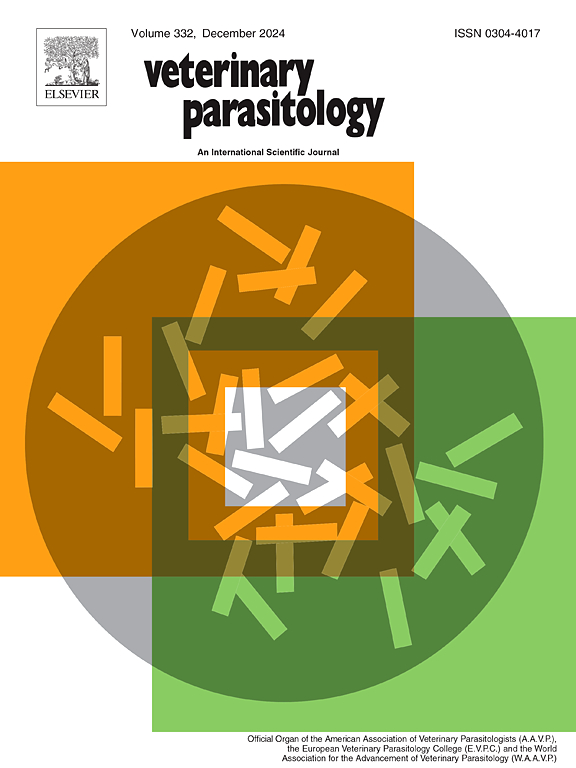Hepatozoon infections in dogs and cats in USA: History, life cycle, and suggestions for uniform terminology for hepatozoonosis in endotherms and ectotherms
IF 2
2区 农林科学
Q2 PARASITOLOGY
引用次数: 0
Abstract
Hepatozoonosis can cause serious illness in dogs in the USA resulting in muscle weakness and bone deformities. It is often fatal, and treatment is expensive and not curative. There are two recognized species of Hepatozoon which infect dogs, Hepatozoon canis and Hepatozoon americanum, transmitted by ticks, Rhipicephalus sanguineus sensu lato and Amyboloma maculatum, respectively. Hepatozoon canis has worldwide distribution and H. americanum is currently confined to the USA. Wildlife reservoirs of H. americanum have not been established but coyote (Canis latrans) is suspected, and infection is common. Most cases of hepatozoonosis in dogs in USA are thought to be due to H. americanum. However, molecular evidence suggests that a minor portion of cases in dogs are due to H. canis, sometimes as coinfection. Hepatozoonosis in domestic and wild felids, caused by Hepatozoon felis and Hepatozoon silvestris, but also H. canis, has been reported from several countries but little is known of its occurrence in domestic cats or wild felids in the USA. Here, life cycle stages of Hespatozoon spp. in dogs are compared and illustrated. Recently, a new species of Hepatozoon, Hepatozoon rufi, was described from bobcats in Mississippi, USA. There is considerable confusion concerning the terminology for different developmental stages in the life cycle of mammalian Hepatozoon spp. Here, the authors review hepatozoonosis in dogs and cats in the USA and propose a uniform terminology for the life cycle stages.
美国狗和猫的肝人畜共患病:历史,生命周期,以及对恒温动物和恒温动物肝人畜共患病统一术语的建议
在美国,肝人畜共患病会导致狗患上严重的疾病,导致肌肉无力和骨骼畸形。它通常是致命的,治疗费用昂贵且无法治愈。目前已知的两种感染犬的肝虫分别是犬肝虫和美洲肝虫,它们分别由蜱、感血根头虫和斑点淀粉瘤传播。犬肝虫分布在世界各地,而美洲肝虫目前仅局限于美国。美洲嗜血杆菌的野生宿主尚未建立,但怀疑是土狼(Canis latrans),感染很常见。在美国,狗的大多数肝人畜共患病病例被认为是由于美洲嗜血杆菌。然而,分子证据表明,狗的一小部分病例是由于犬嗜血杆菌引起的,有时是合并感染。家养和野生猫科动物的肝人畜共患病,由猫肝人畜共患病和西林肝人畜共患病以及犬肝人畜共患病在一些国家都有报道,但在美国的家猫和野生猫科动物中却鲜有报道。在这里,比较和说明了狗的Hespatozoon的生命周期阶段。最近,在美国密西西比州的山猫中发现了一种新的肝虫——rufi肝虫。哺乳动物肝人畜共患病生命周期中不同发育阶段的术语存在相当大的混淆。在这里,作者回顾了美国狗和猫的肝人畜共患病,并提出了生命周期阶段的统一术语。
本文章由计算机程序翻译,如有差异,请以英文原文为准。
求助全文
约1分钟内获得全文
求助全文
来源期刊

Veterinary parasitology
农林科学-寄生虫学
CiteScore
5.30
自引率
7.70%
发文量
126
审稿时长
36 days
期刊介绍:
The journal Veterinary Parasitology has an open access mirror journal,Veterinary Parasitology: X, sharing the same aims and scope, editorial team, submission system and rigorous peer review.
This journal is concerned with those aspects of helminthology, protozoology and entomology which are of interest to animal health investigators, veterinary practitioners and others with a special interest in parasitology. Papers of the highest quality dealing with all aspects of disease prevention, pathology, treatment, epidemiology, and control of parasites in all domesticated animals, fall within the scope of the journal. Papers of geographically limited (local) interest which are not of interest to an international audience will not be accepted. Authors who submit papers based on local data will need to indicate why their paper is relevant to a broader readership.
Parasitological studies on laboratory animals fall within the scope of the journal only if they provide a reasonably close model of a disease of domestic animals. Additionally the journal will consider papers relating to wildlife species where they may act as disease reservoirs to domestic animals, or as a zoonotic reservoir. Case studies considered to be unique or of specific interest to the journal, will also be considered on occasions at the Editors'' discretion. Papers dealing exclusively with the taxonomy of parasites do not fall within the scope of the journal.
 求助内容:
求助内容: 应助结果提醒方式:
应助结果提醒方式:


